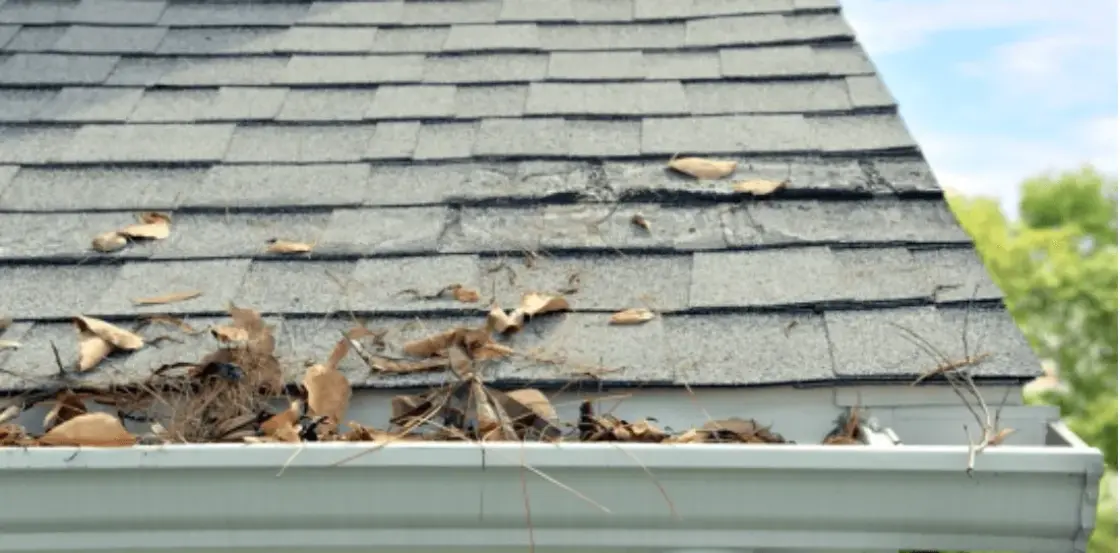When is the Best Time of Year to Clean Out Gutters

When it comes to seasonal home maintenance, you may be wondering, “When is the best time of year to clean out gutters?” Cleaning out your gutters is something most of us don’t think about unless there’s a problem or piles of leaves and debris become hard to ignore. This essential home maintenance task may not be glamorous, but it’s necessary.
Depending on where you live, you may need to winterize your gutters, rake leaves, power-wash your siding, put up storm windows, and take care of other home maintenance tasks that can quickly add up.
When it comes to cleaning out your gutters, the general recommendation is twice a year: once in the spring and once in the fall. However, your specific climate, surrounding vegetation, and other factors, depending on where you live, can increase frequency.
Don’t worry, we’ll dig into the details on the best time of year to clean out your gutters, with expert tips and advice, so you can clean out your gutters at the right time of year to avoid costly issues or an overwhelming home maintenance schedule.
The Benefits of Regular Gutter Cleaning
Gutters can sometimes be out of sight and out of mind, but overlooking the importance of regularly cleaning can lead to costly repairs and a shortened lifespan of your gutter system.
Help Prevent Expensive Water Damage
Clogs inside your gutters can quickly lead to water damage if left unaddressed. Signs your gutters might be clogged include visible debris buildup, dark streaks on siding beneath eaves, overflows during rain, or plants growing from the troughs. These clogs, if left in place, can send water to unwanted areas such as your roof decking, siding, and behind exterior walls. The cost of repairing water damage in those areas can range from $3,000-$8,000, according to Forbes, especially if framing or insulation is water-impacted.
Keeping your gutters cleaned out allows water to flow properly through them, where it makes its way down the downspouts and drains properly out into your yard, away from your home and foundation.
Extend Gutter Lifespan
Regular cleaning not only helps you avoid costly repairs but also extends the lifespan of your gutters. When water flows properly, gutters are less likely to accumulate rust and corrosion. Standing water in clogged gutters can lead to the formation of holes and gaps, which require replacement or repair. If you’re not paying to replace the gutters or repair your foundation, you’ll have more funds to use for improving curb appeal or interior home upgrades.
Best Times to Clean Out Gutters by Season
Deciding when and how often to clean out your gutters can be overwhelming. When you consider where you live, what your climate is like, and how much vegetation you have growing around your home, you can create a schedule that’s easy to stick to.
Late spring and early fall are usually the best times to schedule gutter cleaning, because it will help prepare your gutters for heavy-use seasons by clearing winter debris before spring rains and removing fall leaves before winter freezes. Let’s analyze each season to help you determine the best plan for your household.
Spring Cleaning
Prepare for spring showers by clearing out any remaining winter debris or twigs from snowstorms in the gutters. Be on the lookout for pollen buildups that can be sticky and trap more leaves. Depending on the vegetation, fallen blossoms and seed pods can build up and require extra attention, making spring an ideal time to clean out the gutters. This is especially important in northern climates and snow-prone regions recovering from winter.
Summer Maintenance
Depending on where you live, summer can bring heavy rains or thunderstorms that may cause damage. Summer gutter maintenance serves as a mid-year checkpoint to address minor clogs and ensure water is flowing properly. If you live in heavy rainfall areas, clogs will quickly become apparent due to overflowing or poor drainage.
Fall Preparation
Cleaning in the fall is recommended to ensure there are no blockages before winter snow arrives. Depending on how much vegetation is near your home, you may have heavy leaf drops to clear out. Handling fall gutter cleaning for those in areas with deciduous tree coverage, particularly in the Northeast and Midwest, is key to helping prevent blocked downspouts in the winter.
Winter Considerations
Those in northern and snow-prone regions should plan to schedule their gutter cleaning in early winter before temperatures regularly drop to below freezing, and water can still flow properly. When cleaning or checking gutters in colder months, choose a time during midday on a sunny afternoon when frost has melted. Be sure to avoid cleaning after heavy snowfalls, which can make roofs and ladders slippery.
Other Factors to Consider for Gutter Cleaning
Gutter maintenance isn’t one-size-fits-all—your ideal cadence depends on roofline complexity, nearby trees, climate, and recent storms. Use the tips below to tailor inspections and cleanings so water flows freely and your home stays protected.
Quarterly Inspections
Even if you only need a full gutter cleaning twice a year, it’s smart to visually inspect your gutters quarterly. An inspection, which differs from a cleaning, is a time to check for loose, leaking or sagging sections in order to get ahead of any costly repairs. Each season brings different debris, and sticking to a quarterly inspection routine helps maintain performance year-round and helps prevent foundation issues.
Special Circumstances
You may need to clean out your gutters outside of your regular schedule, such as before or after a severe storm, to help prevent damage. If gutters overflow, check immediately for clogs or misaligned areas that could block water flow. If you notice water stains on the house, it’s time to double-check beneath the gutters for discoloration, which could mean a leak is present. See plants sprouting from your gutters? Remove the vegetation, as roots can trap water and weaken the gutter’s structure.
Tree-Specific Cleaning
Different trees shed leaves at different times, so your gutter cleaning schedule should match the species around your home. It’s important to consider the trees closest to your roofline and when you’re likely to see peak leaf or needle drop.
Maples and Oaks: Shed their leaves heavily in the middle or end of fall. Plan to clean after their leaves drop by the end of Fall or early winter.
Beeches and Some Oaks: American beech and certain oak tree varieties tend to hold onto their dead leaves well into winter (a trait called marcescence). If you have these trees, consider an additional cleaning in late winter or early spring to clear the delayed leaf drop.
Pine Trees and Evergreens: Pine trees drop their needles year-round, and if they’re in your landscaping, you may need to check your gutters regularly.
Mixed Tree Yards: If your yard features a mix of deciduous trees (maples and oaks) and pines, a fall and spring cleaning schedule is recommended, along with additional checks throughout the year.
Regional Differences
The climate and region of your home will greatly impact the best time of year to clean out gutters. Snowbelt regions have shorter cleaning windows before winter freezes arrive, and should take advantage of late fall to avoid snow. Temperate climates have multiple tree shedding cycles, which can require more frequent gutter checks.
Desert areas have fewer rainstorms or leaves to worry about, but dust and windblown debris can cause clogs. Wooded regions are surrounded by trees, meaning leaf drops are heavy. Those in wooded areas may need to clean out gutters up to four times a year to maintain water flowing properly through gutters and downspouts.
When Should You Clean Out Your Gutters?
| Factor | Recommended Frequency | Ideal Timing | Notes |
|---|---|---|---|
| Temperate Climates | 2×/year | Late spring (May–June) & late fall (Oct–Nov) | Typical deciduous tree cycles; avoid winter clogs |
| Snow-Prone Regions | 2–4×/year | Pre-snow (Oct), post-thaw (April), late spring | Reduce the risk of winter blockage |
| Heavy Rainfall Areas | 3–4×/year | Early spring, early summer, fall, late fall | Frequent rains increase debris movement and overflow risk |
| Desert / Arid Regions | 1×/year | Fall or winter post rainy season | Minimal tree fall; mainly dust/dirt accumulation |
| Evergreen or Pine Tree Areas | 3–4×/year | Quarterly or after major drops (e.g. March, June, Sept, Dec) | Pine needles fall year-round; small but dense debris |
| Oak, Maple, Other Deciduous | 2×/year | After full leaf fall (Nov) and spring pollen drop (May) | Leaves and pollen pods clog quickly, especially downspouts |
| High Wind Zones / Storm Areas | After major storms | Trigger-based (within days of heavy weather) | Wind blows twigs, leaves, roof granules into gutters |
| Homes With Gutter Guards | 1–2×/year (inspection only) | Early spring and fall | Check for buildup on top or clogs in downspouts |
| No Nearby Trees | 1×/year | Fall (October–November) | Check for shingle grit, dust, or bird nests |
| Homes Near Tall Trees (Close proximity) | 3–4×/year | Spring, midsummer, early fall, late fall | Overhanging trees shed more leaves and seed pods |
Benefits of Cleaning Gutters at Optimal Times
Syncing your gutter cleaning schedule with seasonal changes helps protect your home when it’s most vulnerable, extends the lifespan of your gutters, and reduces the need for emergency repairs. Being prepared and cleaning at optimal times means you won’t be scrambling to clean in dangerous conditions or needing to climb a ladder during a snowstorm because of leftover fall leaves. Maintaining a gutter cleaning schedule saves time in the long run and helps keep your gutter system operating smoothly year-round.
Limitations and Considerations
Not all gutters are easy to access, and even cleaning gutters on a single-story home carries risks. Using a ladder always requires extra care to ensure the terrain is flat and the ladder is securely placed to avoid falls. For homeowners looking to clean out gutters without a ladder, there are special tools and attachments for clearing debris from the ground. Multi-story homes may require special equipment such as extra tall ladders, ladder stabilizers, roof harness systems, or even scaffolding for stable access. Weather-related constraints, such as high winds, heavy rainfall, or frost, can make gutters slippery and dangerous to access.
Gutters can also be home to bee hives, rodents, or wasps, which are tricky to handle and can be surprising if you’re not prepared.
If the debris load in your gutters is heavy, you’re battling dangerous pests, or if they’re hard to reach, it may be better to rely on an expert gutter cleaning service with the proper equipment and safety materials needed for the job.
Comparison of Professional vs. DIY Gutter Cleaning
When it comes to deciding whether to take a DIY approach to gutter cleaning or hire professionals, it’s important to weigh the cost, risk, and time investment to make the best decision.
The DIY approach
- Time: It takes 4-6 hours every few months and over 100 total hours of personal time in a decade.
- Risk: Improper ladder placement, working at dangerous heights, and a lack of safety equipment can lead to unwanted falls or injuries. Inclement weather heightens these risks.
- Cost: Neglect and repairs can quickly add up to $2,000-$10,000 in costs and range from $10,000-$50,000 over five years.
Professional Gutter Cleaning
- Time: Depending on the size and story level of the home, professional crews can get the job done in 1-2 hours for a single-story home, and 2-4 hours for a multi-story home.
- Risk: Crews are insured, use OSHA-certified equipment, and use professional-grade fall protection like harnesses and stabilizers. They are trained to catch hidden issues (rotting fascia, leaks, misalignment) that homeowners may overlook.
- Cost: Professional gutter cleaning costs typically range from $200-$500 per cleaning. Find your professional gutter cleaning estimate today to see how you can save money in the long run.
No More Cleaning Out Gutters – Guaranteed, With LeafFilter
If cleaning out your gutters sounds complicated and dangerous, invest in LeafFilter today. As a leading gutter protection company, LeafFilter provides professional gutter cleaning services, gutter guards, and gutter installations that help keep your home protected throughout the year. Our experienced local experts remove all debris to help keep your gutters functioning properly. If you’re interested in adding affordable peace of mind, learn more today.
Frequently Asked Questions
How often should I clean out gutters if I have trees nearby?
You should be cleaning gutters at least twice a year (spring and fall) or more, depending on the type of trees you have nearby. Pine and evergreen trees drop needles year-round and may require up to four cleanings a year with regular quarterly checks. Trimming trees with branches hanging over your home can help prevent leaves, twigs, blossoms, and tree debris from building up. We recommend hiring professional tree trimmers to avoid risk.
Can I clean out gutters immediately after a rainstorm?
No, using a ladder on wet ground significantly increases your risk of slips and falls. Resist the urge to remove wet debris because water makes leaves, sticks, and other materials much heavier and more difficult to handle, potentially causing you to lose your balance. Instead, wait for dry conditions or take preventative measures by cleaning your gutters before storm season arrives. On dry days, inspect for holes, leaks, or structural weaknesses that could worsen during heavy rainfall. Or get ahead of the storms by having gutter guards professionally installed to block leaves and debris from entering gutters, reducing the risk of clogging and buildups.
What safety precautions should I take in cold weather?
When checking or cleaning gutters in cold weather, watch out for ice on ladders, walkways, and roofs, as even thin layers can be slippery. Be sure to wait for snowstorms to pass and for ice to melt on sunny afternoons or midday. Wearing warm, comfortable clothing that you can move in is always recommended. Safety features such as waterproof gloves or non-slip boots can help you maintain dexterity and avoid slipping.
Is professional gutter cleaning worth the cost?
Yes. Cleaning gutters yourself often takes up to 6 hours, and without proper safety equipment or correct ladder placement, it can lead to serious injury. Professional gutter cleaners are insured, use OSHA-certified equipment, and have professional-grade fall protection. They’re guaranteed to thoroughly remove debris from hard-to-reach places and conduct routine quality control checks. Neglecting gutter cleaning or failing to remove all clogs can lead to thousands of dollars in home repairs. It’s an investment that pays for itself.


